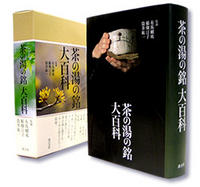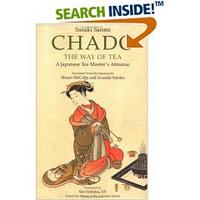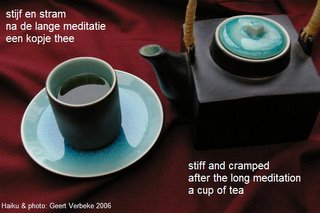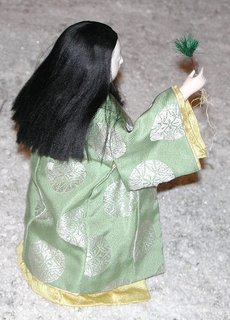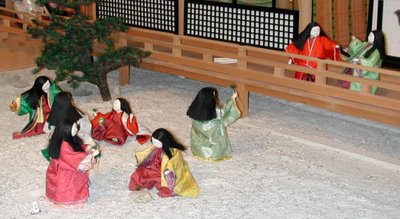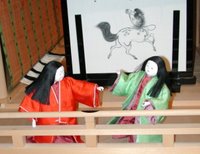:::::::::::::::::::::::::::::::::::::::::::::::::::::::::::::::::::::::::::::::::::::::::::::::::::::
Rainbow (niji)
***** Location: Japan
***** Season: All Summer and see below
***** Category: Heaven
*****************************
Explanation
A rainbow in the sky ... a kind of bridge to our future good luck !

niji 虹 にじ rainbow レインボ
futae niji 二重虹(ふたえにじ)double rainbow
asaniji 朝虹 (あさにじ) morning rainbow
yuuniji 夕虹(ゆうにじ)evening rainbow
niji no wa 虹の輪(にじのわ) "circle of a rainbow"
. . . CLICK here for Photos !
niji no hashi 虹の橋(にじのはし)bridge of a rainbow
niji no obi 虹の帯(にじのおび)belt of a rainbow
niji no hari 虹の梁(にじのはり) beam of a rainbow
:::::::::::::::::::::::::::::::::::::::::::::::::::::::::::::::::::::::::::::::::::::::::::::::::::::
Contribution by Larry Bole, June 2006:
In "Haiku World," Higginson has this to say about 'rainbow' as a kigo:
"Rainbows can be seen at any time of year when an observer stands between the sun and a rain-shower cloud---provided the angles are right and the sky is clear in the right place. ... Conditions for seeing rainbows are more common in summer in most of the temperate zones, accounting for the assignment of RAINBOW (niji) to summer in the saijiki.
But they also occur at other times, so the topics SPRING RAINBOW (haru no niji) and AUTUMN RAINBOW (aki no niji) are recognized as well as WINTER RAINBOW (fuyu no niji)."
Higginson then gives a rainbow haiku by Shuuson Kato (Kato Shuson):
Thou too Brutus! 今も冬虹消えやすく
Thou too Brutus! ima mo fuyu niji kieyasuku
Et tu, Brute!
even now a winter rainbow
ready to disappear
I must confess, I don't understand this haiku.
However, in areas that have 'rainy seasons', 'rainbow' would be a kigo for whatever time of year the 'rainy season' is. One such place is described in the introduction, written by Shugyo Takaha, for the book "Kiyoko's Sky: The Haiku of Kyoko Tokutomi"
http://www.brooksbookshaiku.com/translations/kiyokohaiku.html
"In San Francisco . . . winter is the rainy season, and especially around New Year, it rains often. It is then that you can see a rainbow.
"Therefore, 'rainy season' and 'rainbow' would be winter kigo there."
One rainbow haiku I like, by Yoshiko Yoshino, translated by Lee Gurga and Emiko Miyashita:
This is in her book "Tsuru" in the 'summer' section.
sango saku umi ni umarete niji awashi
born in the sea
born in the coral flowers:
the faint rainbow
Thou too Brutus!
Shuson wrote this haiku during WWII, when he returned from an official visit to China and found his haiku friends in a lot of disagreement about the proper form.
:::::::::::::::::::::::::::::::::::::::::::::::::::::::::::::::::::::::::::::::::::::::::::::::::::::
In our Library:
RAINBOW, COLOURS AND SCIENCE MYTHOLOGY
by Virve Sarapik
Rainbows in mythology. Wikipedia
:::::::::::::::::::::::::::::::::::::::::::::::::::::::::::::::::::::::::::::::::::::::::::::::::::::
kigo for late spring
haru no niji 春の虹 (はるのにじ) rainbow in spring
hatsuniji 初虹(はつにじ) first rainbow (of the new year)
:::::::::::::::::::::::::::::::::::::::::::::::::::::::::::::::::::::::::::::::::::::::::::::::::::::
kigo for all autumn
aki no niji 秋の虹 (あきのにじ) rainbow in autumn
..... akiniji 秋虹(あきにじ)
:::::::::::::::::::::::::::::::::::::::::::::::::::::::::::::::::::::::::::::::::::::::::::::::::::::
kigo for all winter
fuyu no niji 冬の虹 (ふゆのにじ) rainbow in winter
. SAIJIKI
HEAVEN in all seasons
:::::::::::::::::::::::::::::::::::::::::::::::::::::::::::::::::::::::::::::::::::::::::::::::::::::
:::::::::::::::::::::::::::::::::::::::::::::::::::::::::::::::::::::::::::::::::::::::::::::::::::::
Rainbow in Kenya
The Bahati Haiku Club
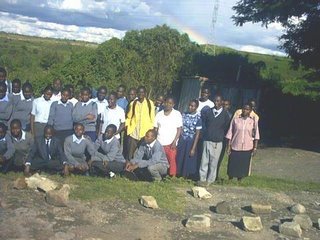
Photo : Patrick Wafula, May 2006
http://groups.yahoo.com/group/worldkigoparkinglot/message/584
The Kenya Saijiki
*****************************
Worldwide use
Germany
Regenbogen
Takayanagi Shigenobu (1923-1983) wurde von Kakio Tomizawa in die Welt des Haiku eingeführt. Von französischer moderner Literatur beeinflußt, schrieb er als erster Haiku in vier und mehr Zeilen und viele Haiku in der traditionellen Ein-Zeilen-Form unter den Namen Semio Yamakawa. Seine Haiku sind suggestiv, symbolisch, vielfach erotischer Natur oder voll Todesahnungen.(26)
Kann’ichi Abe interpretiert das folgende Haiku von Takayanagi Shigenobu, dem zum Vergleich zwei deutschsprachige vorangestellt sind.
Steh vor dem Abgrund –
Ein Regenbogen allein
spannt sich darüber.
(Imma von Bodmershof)
in pflasterpfützen
spielt eine ölspur .. ich bin
der regenbogen ..
(Roman York)
Mi o sorasu niji no
Zetten
Shokeidai
(Takayanagi Shigenobu)
Zurückgebeugt zum
höchsten Punkt des Regenbogens
Richtstätte
Das Haiku beschreibe eine fremde Landschaft tiefenpsychologisch. Der Begriff Regenbogen, im klassischen Haiku ein Sommer-Jahreszeitenwort, verliere hier jede kigo-Funktion und werde zum Bild, zum Symbol. "Es geht hier nicht um die Beschreibung der äußeren Welt; dieses Werk spielt im Inneren des menschlichen Denkens."(27)]
© Aspekte moderner deutschsprachiger Haiku, Mario Fitterer
Takayanagi Shigenobu 高柳 重信;
(* 9. Januar 1923 in der Stadt Tokio (heute Tokio); † 8. Juli 1983) war ein japanischer Haiku-Dichter.
Takayanagi studierte Jura an der Waseda-Universität. Hier gab er die Haiku-Zeitschriften Mure und Sōdai haiku heraus. Nachdem die meisten progressiven Haiku-Zeitschriften, darunter seine eigenen, verboten worden waren, publizierte er in Kikan. Unmittelbar nach dem Krieg gründete er Mure neu und außerdem die Zeitschrift Chōki.
1947 wurde er Schüler des Dichters Tomizawa Kakio, der westliche Einflüsse in die japanische Haiku-Dichtung einbrachte. Mit diesem gründete er 1952 die Avantgardezeitschrift Bara. 1958 gründete er Haiku hyorōn, und 1967 wurde er Redakteur der Zeitschrift Haiku kenkyū. Er veröffentlichte sechs eigene Gedichtbände: Fukiok (蕗子; 1950), Hakushakuryō (伯爵領; 1952), Kuromisa (黒彌撒; 1956), Aomisa (青彌撒; 1974), Sengaishū (山海集; 1976) und Nippon kaigun (日本海軍; 1979).
- source : wikipedia -
:::::::::::::::::::::::::::::::::::::::::::::::::::::::::::::::::::::::::::::::::::::::::::::::::::::
Hawaii

© Mussell Family
http://www.mussell-family.com/ hawaii/
We can see rainbows throughout the year, so it might rather be a non-seasonal topic for haiku.
Look at more rainbows from Hawaii.
Water falls down not up
Palette of color waits all
Rainbow in the mist
© Charles Garcia, Honolulu Hawaii, March 2005
http://poemhunter.com/p/m/poem.asp?poet=127952&poem=2798826
*****************************
Things found on the way
circumhorizontal arc
caused by light passing through wispy, high-altitude cirrus clouds. this sight occurs only when the sun is very high in the sky. what's more, the hexagonal ice crystals that make up cirrus clouds must be shaped like thick plates with their faces parallel to the ground.
when light enters through a vertical side face of such an ice crystal and leaves from the bottom face, it refracts, or bends, in the same way that light passes through a prism. if a cirrus's crystals are aligned just right, the whole cloud lights up in a spectrum of colors
"fire rainbow"
© More in the WIKIPEDIA !

what is fire ...
a rainbow meditating
in clouds ?
- Shared by Louis Osofsky -
Joys of Japan, 2012
photo credit : National Geographic News, 03 June 2006
{over northern Idaho near the Washington State border}
:::::::::::::::::::::::::::::::::::::::::::::::::::::::::::::::::::::::::::::::::::::::::::::::::::::::
quote
In Japan, July 16 is Rainbow Day!
This isn’t a well-known holiday. In fact, it mainly involves wordplay. With a great deal of manipulation, you can represent that date in Japanese as なないろ (七色: 7 colors).
なな (七: 7) stands for July, the 7th month
い is an abbreviation of いち, the 1 of 16
ろ is an abbreviation of ろく, the 6 of 16
After all that, the day isn’t known as nana iro 七色 but rather as
niji no hi 虹の日 (にじのひ: Rainbow Day).
source : Joy o Kanji - Eve Kuschner
*****************************
HAIKU
. WKD : Kobayashi Issa 小林一茶 in Edo .
夕紅葉谷残虹の消へかかる
yuumomiji tani zankoo no kie kakaru
fall leaves at sunset --
in the valley traces of a rainbow
moments before vanishing
Tr. Chris Drake
Written sometime between 1795 and 1800. Since the hokku was written in the margins of Issa's 1795 haibun travelog about his trip to western Japan in 1795, it may be based on a memory of one of the trips he took that year. It is influenced by Chinese poetry, which was popular among haikai poets of the Katsushika school, to which Issa belonged when he was young.
In the hokku there seems to have been a short rainstorm, and the rainbow that formed soon after, when sunlight had returned, has gradually been getting fainter. The ruddy sunlight on the red and yellow leaves intensifies their colors, but now direct sunlight perhaps reaches only the trees on the upper slopes on one side above the valley, since the sun is going down. In the growing shadows the remaining traces of the rainbow are now on the verge of disappearing, while the autumn leaves are also gradually losing their intense color. Issa seems to be trying to say goodbye to two friends at the same time, and there is a palpable overtone of loneliness.
Chris Drake
:::::::::::::::::::::::::::::::::::::::::::::::::::::::::::::::::::::::::::::::::::::::::::::::::::::
multiple coloured bow
streaking across the sky
in a sunny drizzle
Patrick Wafula
http://kenyasaijiki.blogspot.com/2005/12/long-rains.html
xxxxxxxxxxxxxxxxxxxxxxxxxxxxx
Regenbogen !
Mutters Hand tastet
nach meiner
rainbow !
mother's hand reaches
for mine
Gabi Greve, 2006
xxxxxxxxxxxxxxxxxxxxxxxxxxxxx
rainbow --
the cool colors
on the leaves

(c) 2006 知美 (chibi)< , America, September 2006
:::::::::::::::::::::::::::::::::::::::::::::::::::::::::::::::::::::::::::::::::::::::::::::::::::::
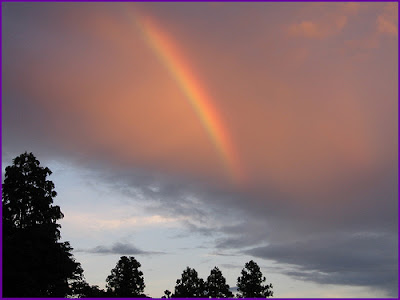
初盆や夕日の雲に虹のある
first Bon ceremony -
a rainbow joins
the sunset clouds
Gabi Greve, Japan, August 13, 2007
It was the first O-Bon ceremony for our late neighbour.
The rainbow seemed to show his spirit on the way down to our valley.
:::::::::::::::::::::::::::::::::::::::::::::::::::::::::::::::::::::::::::::::::::::::::::::::::::::

a whip-poor-will's song
the taste of rainbow
in my tea
"The Eastern Whip-poor-will, Caprimulgus vociferus, is a medium-sized (22–27 cm) nightjar bird from North and Central America. The whip-poor-will is commonly heard within its range, but less often seen because of its superior camouflage. It is named onomatopoeically after its song."
© More in the WIKIPEDIA !
- Shared by Sandi Pray -
Joys of Japan, 2012
*****************************
Related words
***** Bridge (hashi)
:::::::::::::::::::::::::::::::::::::::::::::::::::::::::::::::::::::::::::::::::::::::::::::::::::::
[ . BACK to DARUMA MUSEUM TOP . ]
[ . BACK to WORLDKIGO . TOP . ]
:::::::::::::::::::::::::::::::::::::::::::::::::::::::::::::::::::::::::::::::::::::::::::::::::::::
